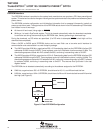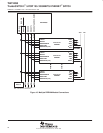
TNETX4090
ThunderSWITCH II
9-PORT 100-/1000-MBIT/S ETHERNET
SWITCH
SPWS044E – DECEMBER 1997 – REVISED AUGUST 1999
39
POST OFFICE BOX 655303 • DALLAS, TEXAS 75265
Table 10. Transmit Pretag Bit Definitions
BIT NAME FUNCTION
31–28 reserved Reserved. These bits always are 0.
27 rxheader
Receive header. Indicates whether an IEEE Std 802.1Q header was added to the frame on reception.
– When rxheader = 1, an IEEE Std 802.1Q header was inserted.
– When rxheader = 0, no IEEE Std 802.1Q header was inserted.
26–25 reserved Reserved. These bits always are 0.
24–20 portcode
Source port code. Indicates which port on the device received the frame. Codes 00000–01001 indicate ports 0–9,
respectively (port 9 is the NM DIO port). All other codes are reserved and are not generated.
19–17 reserved Reserved. These bits always are 0.
16–0 xportvector
†
Extended destination port vector. A bit for each port on the crossbar matrix. A 1 in position n indicates the frame is
destined for port n on the crossbar matrix.
†
Bit vector, in which bit x corresponds to external crossbar matrix port x. Any number of ports can be selected at the same time.
pretag on reception
Port 8 can receive two tag formats, learning and directed, over eight cycles, beginning with the first cycle that
M08_RXDV is high. The pretag takes the form of a 32-bit value (divided into eight nibbles), with each nibble
being replicated on M08_RXD3–M08_RXD0 and M08_RXD7–M08_RXD4. This replaces the preamble and sof
delimiter normally received at this time.
Figure 6 shows the timing relationship, and Table 11 and Table 12 show the fields within the tag for learning and
directed format, respectively.
Frame Data
M08_RXD7–
M08_RXD4
3–0 7–4 11–8 15–12 19–16 23–20 27–24 31–28 Frame Data
M08_RXD3–
M08_RXD0
M08_RXDV
M08_RCLK
NOTE: Ranges (e.g., 3–0) indicate which bits of the 32-bit pretag are input in each cycle.
Figure 6. Receive Pretag Timing
Table 11. Learning Format Receive Pretag Bit Definitions
BIT NAME FUNCTION
31 0
Zero. Indicates learning format. Frames received with this tag format are routed using the device internal frame-routing
algorithm. When the source address is learned, the crossbar matrix port number, indicated by xportcode, also is
learned, and is used to create the xportvector output as part of the transmit pretag for frames subsequently routed to
this address.
30–5 reserved Reserved. Bits 30–5 are ignored.
4–0 xportcode
‡
Source port code. Portcode indicates which port on the device received the frame. Codes 00000–10000 indicate
ports 0–16, respectively. All other codes are reserved and are not generated.
‡
Binary code that selects a single port on this device or an external crossbar matrix connected to port 8


















